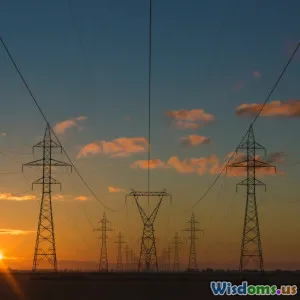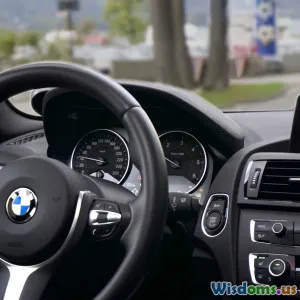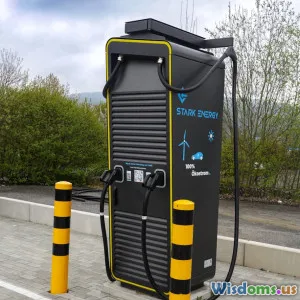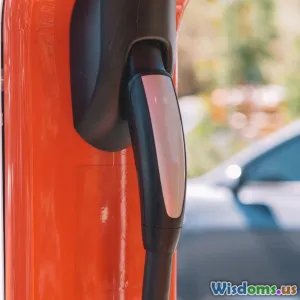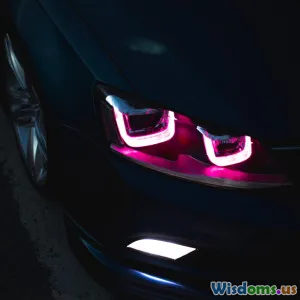
Are Inductive Chargers Efficient Enough for Long Road Trips
17 min read Explore if inductive charging technology is efficient and practical for electric vehicles on extended road trips. (0 Reviews)
Are Inductive Chargers Efficient Enough for Long Road Trips?
When the open road calls, electric vehicle (EV) drivers face a dilemma: can cutting-edge charging technologies, specifically inductive (wireless) chargers, keep pace with the demands of long expeditions? The promise of rolling over a pad and topping up an EV battery without wrestling with cumbersome cables has captured the imagination of motorists and manufacturers alike. But do these convenient systems stack up when the rubber meets the road on extended journeys?
This article examines whether inductive chargers are efficient enough for long road trips, comparing traditional plug-in alternatives and delving into the practical realities, recent advances, and forward-thinking developments shaping the future of EV mobility.
The Mechanics of Inductive Charging

Inductive charging, also known as wireless charging, transmits energy between a charging pad on the ground and a receiver in the vehicle through electromagnetic fields. This is similar technology to what charges your smartphone, but scaled for high power transfer necessary for EVs. Convenience is the main allure: drivers simply park above a pad, and charging begins automatically—no plugging in, no physical connectors.
How does it actually work? Coils within the charging pad create an oscillating electromagnetic field when powered. a similar set of coils on the EV “pick up” this field, inducing a current, which is regulated and converted to charge the vehicle’s battery. The alignment, distance between coils, and the technology used determines how much power successfully gets transferred.
Key Specifications
- Power levels: Modern wireless systems for EVs are typically rated from 3.6kW (similar to Level 2 home charging) up to recent demonstrations at 20kW or higher for buses and commercial vehicles.
- Industry standards: Chargers adhering to the SAE J2954 standard ensure interoperability among different vehicles and charger installations, a crucial advancement for widespread adoption.
Example: In 2020, BMW's wireless charging option for the 530e plug-in hybrid sedan could supply up to 3.2 kW, recharging the car in about three and a half hours—decent for overnight, but lagging behind fast plug-in solutions.
Comparing Efficiency: Inductive vs. Plug-in Charging

Plug-in chargers are the backbone of current EV road trip infrastructure. They are highly efficient, inexpensive to produce, and capable of very high charge rates. Inductive chargers, while innovative, struggle to match their power and energy transfer efficiency in several ways:
Energy Transfer Losses
- Plug-in chargers: Can reach efficiencies of 95-99%, meaning that almost all the electricity consumed from the grid ends up in the car’s battery.
- Inductive chargers: Most wireless pads reach 85-93% efficiency under optimal conditions. Even advanced, perfectly aligned systems hover just below the best plug-ins. Misalignment, extra separation, or environmental factors (like debris or water) can introduce further energy wastage.
Practical Example
A 7% drop in efficiency seems modest, but over a weeklong trip charging 400 kWh, that’s 28 extra kWh consumed—enough for another 75-100 miles in a modern EV, or about $10-15 in electricity at U.S. rates.
Power Delivery
- DC fast charging (plug-in) stations offer up to 350kW or more, charging most EVs from near empty to 80% in 15-30 minutes.
- Current wireless systems for passenger vehicles struggle to exceed 20kW—a trickle compared to what road trippers need for fast turnarounds.
This power disparity means longer wait times at charging stops, an inconvenience that quickly compounds during road trips that require frequent, brief recharging breaks to maximize travel efficiency.
Real-World Capabilities on Long Road Trips

Imagine a classic American family road trip: from Chicago to the Grand Canyon, over 1,700 miles. Can today’s inductive charging offerings keep pace?
Travel Scenario
Suppose you’re driving a popular EV like the Hyundai Ioniq 5, rated for ~300 miles of range. On a trip of this length, you’d stop for about five full recharges (more with smaller batteries or colder weather).
Inductive scenario: If the best wireless charger available delivers 11kW (some commercial models claim 20kW for fleet/bus applications), a 77kWh battery would take nearly 7 hours for a full charge—and that’s assuming high efficiency and perfect alignment.
Plug-in scenario: With access to a 150kW DC fast charger, you can go from 10% to 80% (roughly 200 miles) in around 18 minutes per stop, keeping you on par with or faster than typical rest breaks.
Current Wireless-Friendly Highway Stops
As of 2024, very few highway rest stops offer wireless pads. The vast majority of high-power inductive installations are in controlled or depot environments: bus terminals (like those in Oslo and Los Angeles), taxi stands, or select city parking garages. Pilots for passenger vehicles exist in Europe and Asia, but they rarely exceed 11kW—the de facto speed of a home wall box.
When Inductive Charging Excels: Urban and Fleet Use

Where does wireless charging shine? The most effective use cases involve predictable, frequent short stops:
- City taxis: In Oslo, wireless pads at taxi ranks let cabs top up during idle periods, reducing range anxiety and charger congestion.
- Buses: Several cities, including Los Angeles, have high-power pads installed at endpoints, allowing short, frequent recharging cycles that help electric buses match diesel bus uptime.
- Ride-hailing fleets: Wireless pads in dedicated lots mean vehicles can recharge without drivers leaving the seat or navigating through a busy lot to plug in.
But for private owners on a 1,000-mile trek? The limited number of wireless-enabled public charging spots and slow charge rates compared to plug-in alternatives diminish the practical value.
Game-Changing Potential: Dynamic Inductive Charging on Highways

The real game-changer may not be stationary wireless chargers—it’s dynamic inductive charging. Instead of stopping to recharge, vehicles could energize on the move, drawing power through coils embedded in the roadway surface.
How Does Dynamic Charging Work?
- Special strips under the pavement are energized as a compatible EV passes over.
- The car detects the strip's location and activates its receiver, drawing just enough current to maintain or extend its battery.
- Communication between vehicle and strip regulates safe operation, maximizing efficiency and limiting electromagnetic exposure.
Example: In Sweden, the ElectReon demonstration line deployed a 1.6-kilometer test of this concept, where buses and trucks equipped with receivers charged while in motion. Initial data shows promise, though widespread rollout will require major infrastructure investments.
Could This Solve Road Trip Charging?
In theory, dynamic charging could minimize—or even eliminate—the need for long stops: vehicles would maintain their charge throughout the journey. Early test routes in Germany, Sweden, and Israel are laying the groundwork, with ambitions to electrify parts of major highways. But given the costs, regulatory challenges, and limited vehicle compatibility, this technology is many years from mass adoption.
Barriers to Inductive Charging Adoption on Long Journeys

While wireless charging presents clear user benefits, several hurdles limit its competitiveness for road trips today:
1. Infrastructure
- Limited deployment: Far fewer wireless-equipped public charging spots exist compared to thousands of fast DC plug-in stations in the U.S., Europe, and Asia.
- Retrofitting costs: Upgrading highway rest stops to support inductive pads is more complex and expensive than installing plug-in chargers, partly due to integration and safety measures.
2. Efficiency Concerns
- Energy wastage: Even at 90% efficiency, retrofitting wireless at scale increases demand on the power grid and makes sustained long-distance travel less eco-friendly per mile than using the cleaner plug options.
3. Interoperability
- Competing standards: Not all vehicles are equipped for stationary wireless charging, and very few are ready for dynamic charging. While standards like SAE J2954 provide a framework, legacy vehicles and cost constraints slow universal adoption.
4. Consumer Awareness & Habits
- Many drivers simply aren’t aware that wireless charging exists for EVs, and those who are tend to see it as a home or workplace perk—not something that would affect or enhance a cross-country expedition.
- Consumer trust in plug-in fast charging is growing, as range anxiety diminishes with network expansions and the normalization of “fueling” times.
Innovations Paving the Way for Next-Generation Inductive Charging

Despite current gaps, research and pilot programs are pushing wireless charging forward:
- Higher power output: Companies like WiTricity and Momentum Dynamics have demonstrated pads delivering up to 50kW or more, moving closer to practical road trip recharge times.
- Better efficiency: Hardware and software improvements—such as smarter alignment detection and real-time gap adjustment—are narrowing the efficiency gap with plug-in systems.
- Automated alignment: New vehicle guidance systems ensure near-perfect coil overlap, maximizing energy transfer and eliminating the "off-center" penalty.
- Interoperable networks: Standardization (e.g., SAE J2954) sets the stage for seamless cross-brand compatibility, improving market confidence.
- Public-private partnerships: Urban pilots lay groundwork for more ambitious highway deployments, collecting real-world performance data critical for planning massive infrastructure upgrades.
Recent example: In 2023, a trial in Detroit installed a short dynamic wireless strip to test how delivery vehicles fare on real roads, an incremental but crucial step toward scalable wireless infrastructure.
Tips for Road Trippers Considering Inductive Charging

If you’re intrigued by the prospect of a cord-free journey or wish to future-proof your long-term investment in electric vehicles, consider the following practical advice:
- Research availability: Check your planned route for wireless-enabled stations. Networks remain sparse, but clusters exist in some progressive urban centers.
- Know your car: Ensure your EV is equipped with a compatible receiver; retrofits exist for major models but often come with a price premium.
- Use hybrid charging strategies: Rely on plug-in fast chargers for long-distance legs and schedule overnight or idle-period wireless charging where available for maximum convenience.
- Stay updated: Technology and infrastructure change quickly. Subscribe to manufacturer, charging network, and EV news sources to be first to know when highways roll out wireless pads or dynamic segments.
- Monitor efficiency: Use onboard data to understand how much energy is lost during wireless charging versus plugged-in sessions. Adjust your route and stop frequency accordingly.
The Future of Road Trip Charging: Outlook and Recommendations

For now, plug-in chargers remain the clear favorite for long road trips, thanks to superior speed, efficiency, and availability. Inductive charging’s current value shines most brightly in settings where convenience and automation trump raw speed, like cities or in fleets. While the promise of rolling roadways and dynamic induction is thrilling, EV drivers planning epic road journeys should expect to rely on robust, ever-expanding plug-in networks for the next decade.
Still, it’s worth keeping a watchful eye on progress: advancing coil designs, smarter vehicle integration, and expanding infrastructure could mean a future where drivers need never touch a charging cable—or wait long for their adventure to continue. As the technology matures and expands, enthusiasm for seamless, wireless energy could finally make long-distance EV road trips as easy as they are green and exhilarating.
Rate the Post
User Reviews
Other posts in Road Trips
Popular Posts












